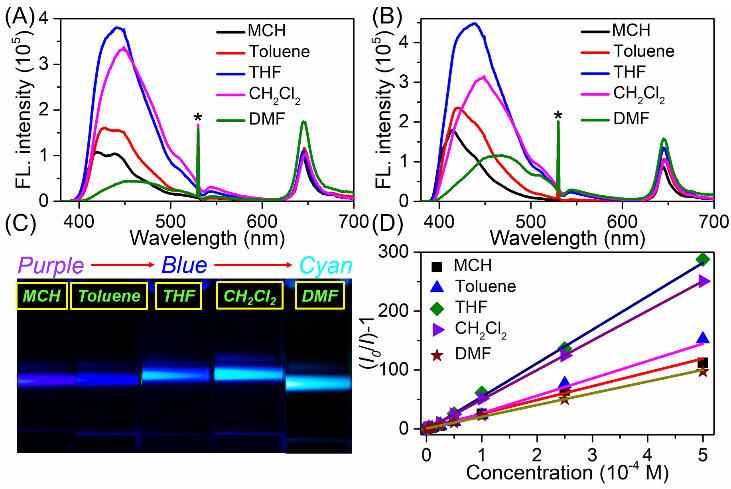Recently, Prof. Li Xiyou’s group from School of Materials Science and Engineering achieved important progress on the study of upconversion materials based on triplet-triplet annihilation (TTA). The article “color-tunable upconversion emission from a twisted intramolecular charge-transfer state of anthracene dimersviatriplet-triplet annihilation” was published onMaterials Horizons. The first author is Dr. Liu Heyuan from Institute of New Energy of UPC, and the corresponding author is Prof. Li Xiyou. China University of Petroleum (East China) is the corresponding affiliation.
TTA upconversion (TTA-UC) process can convert two low-energy photons into one high-energy photon and has many potential applications into organic photovoltaic, photocatalysis,bio-imaging, and therapeutics, etc. However, traditional emitters of TTA-UC only show one color UC emission under single-wavelength excitation, which limits TTA-UC applications on multicolor imaging, complex data analysis, and information storage, etc. Therefore, the development of emitters with color-tunable UC emissions is vital for expanding the TTA-UC application.

The researcher synthesized two covalently linked anthracene dimers and found that the maximum fluorescence peak of these dimers was redshifted gradually with the increase of the solvent polarity. This is due to the formation of the twisted intramolecular charge transfer (TICT) state. More importantly, the fluorescence quantum yield of this TICT state was not influenced by the polarity of the solvent. Taking advantage of this, the researcher used these two dimers as emitters in TTA-UC and achieved color-tunable UC emissions for the first time. The color of the UC emission can be tuned from purple to cyan as the polarity of the solvent increases. This provides a new strategy for the design of TTA-UC emitters. The development of the color-tunable emitters would expand the application of TTA-UC.

Materials Horizonsis a top journal of materials science by Royal Society of Chemistry, which publishes 10 issues per year. Articles published on it have worldwide influences in the field of materials science. The latest impact factor l is 13.183.
Under the support of National Natural Science Foundation of China and Natural Science Foundation of Shandong Province, Prof. Li’s group has been devoted to the study on the mechanism of photo modulation (up/down conversion) and its application into solar cells and photocatalytic splitting of water in recent years. The related results has been published on Energy & Environmental Science, Nano Energy, Materials Horizons, Organic Letters, Journal of Materials Chemistry C, Physical Chemistry Chemical Physics, and ChemCatChem, etc.
Updated: 2019-03-06